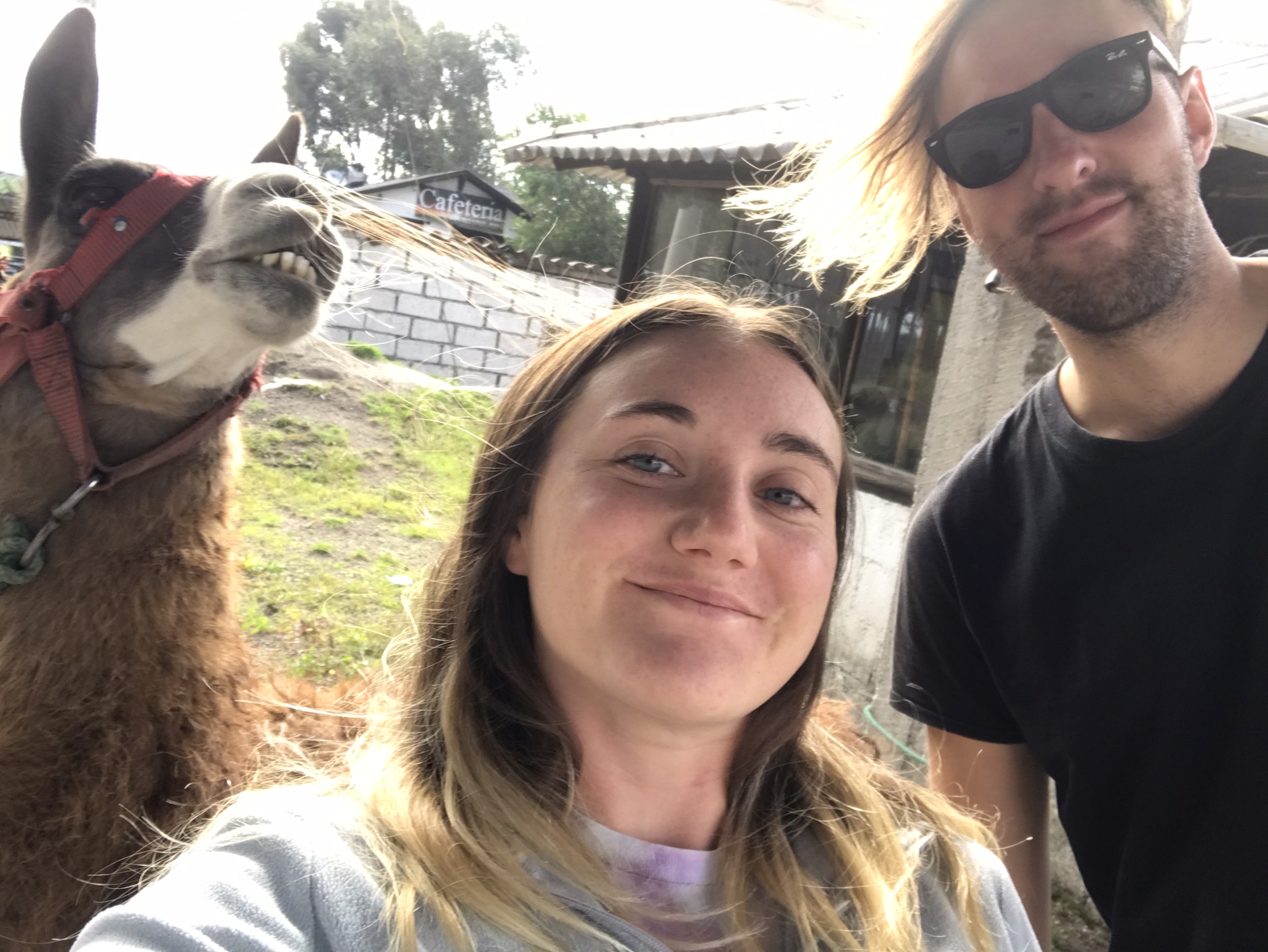We heard whispers that in the near future Albania might become the new Spain, a destination for cheap package beach holidays. We certainly saw the continuous building regime in Durrës of luxury hotel complexes along the Beach of Durrës. Albania is ripe for development. With cheap prices compared to the rest of Europe and warm temperatures, it has a lot of potential as a place for beach bum tourists to go. Meanwhile, inland Albania has plenty of history both antique and modern. Albania travel has something for everyone, with the only barrier to mass tourism being the country’s lack of development and infrastructure compared to many of its neighbours.
Tirana, Durrës, Berat, Shkodër
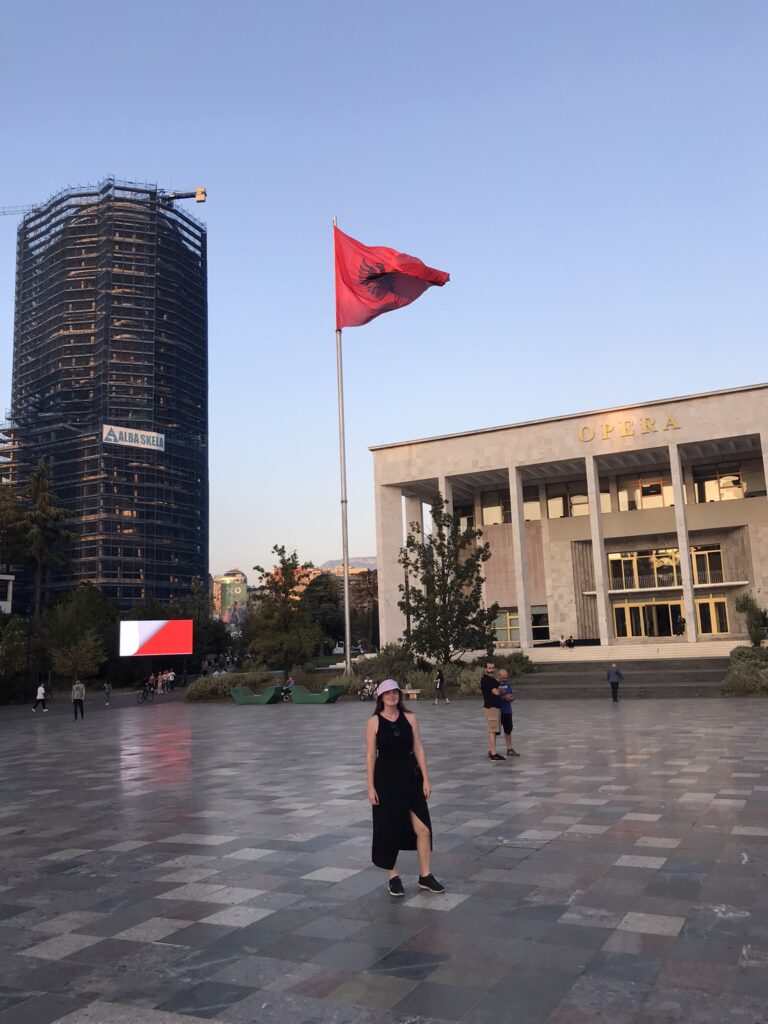
Albania has a certain ‘Wild West’ feeling, more so than any of the other Balkan countries. It’s still trying to catch up with the other Balkan countries in terms of living standards, infrastructure and state services and removing long-standing corruption from the heart of government. Our walking tour guide joked that Albania’s biggest export was people, this isn’t wrong. More Albanians currently live outside the country than actually in Albania, how mad is that!
Did you know that Albania was once similar to North Korea? A repressive, totalitarian communist state from 1946-1991, mainly under the leadership of the dictator Enver Hoxha, the Albanian communist regime banned freedom of movement (you couldn’t leave the country or even move to live in another city), banned freedom of speech especially criticism of the regime, brought in extreme control and censorship of the media as well as the creation of concentration camps and labour camps for political dissidents. Hoxha’s regime is characterised by purges within his cabinet, repression of the people and hostility towards any and all external influences. Albania was cut off from the world with very little information available to the international community about what was actually happening there. Tight state surveillance was imposed upon the people on a grand scale by the Sigurimi (secret police similar to the KGB) including the formation of a web of informants, and hundreds of thousands of underground bunkers were created throughout the country. The communist regime in Albania has been described as the most oppressive in the world and had a huge impact on the country and its people which is still being felt decades later. Despite the negatives there were some positive aspects of the regime, such as industrialisation, improvement of women’s rights and increase of literacy rates amongst the population.
Albanians don’t refer to their country as Albania but rather as the Republic of Shqipërisë, on Government Buildings, national banks and universities, you’ll notice the word Shqipëri in reference to Albania. As in Kosovo, Albanians use the latin script rather than cyrillic (like in Bulgaria, North Macedonia and Montenegro) and the majority of the population identify as Muslim. Skanderbeg is considered the national hero of Albania; he was the leader of a series of revolts against the Ottomans in the 15th century. There are many squares and monuments dedicated to him such as Skanderbeg Square in Tirana, the main square in the city.
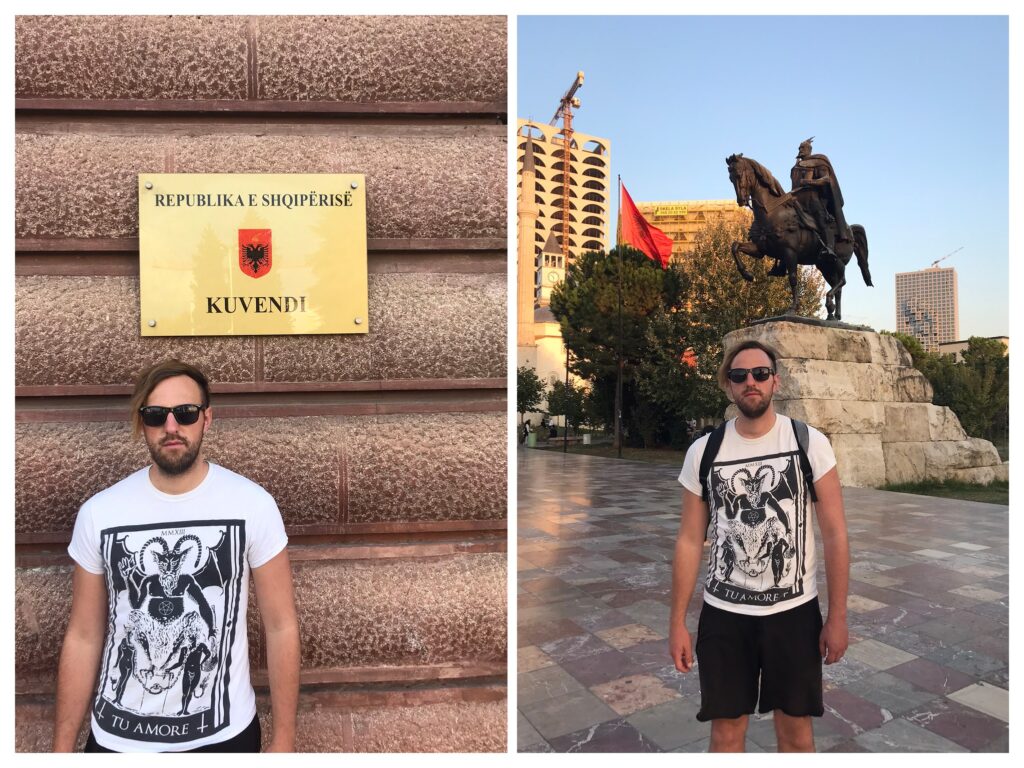
Republic of Shqipërisë Government Building and the national hero, Skanderbeg, in all his glory.
Bus stations in Albania are chaotic and in-your-face. You need to be prepared to walk into a disorganised and shouty scene. Most bus stations you visit in Europe will have a station building with timetables and a ticket office where you can buy a ticket. This is not the case in Albania, the bus stations are just large car parks where the drivers will shout the location they’re going to and each bus will display a sign with the destination. The trick is to keep asking various bus drivers along the line until you finally reach the correct bus. Make sure the sign in the front of the bus window matches your destination. Once you get used to the system, it’s not so bad but the first time you turn up at the bus station it’s very much a shock to the system. Once on board the bus, you have to wait until it fills up with passengers before it departs, the waiting time varies depending on how many passengers you have to wait for. If you’re one of the first passengers, you might have to wait 20 minutes or longer for the bus to leave but if you’re lucky you’ll be one of the last to board. Buses do not have set timetables but there is good coverage throughout the country, don’t be put off if you can’t find information online as it’s likely that buses will be running between most major cities as long as you arrive early enough. We were able to get buses to Durres, Berat and Shkoder and back from Tirana without any trouble. If in doubt, ask a local.
Albania also happens to be the only country in the Balkans that we experienced food poisoning, although that may have been down to my cooking! Many of the communist-era buildings have old style water tanks and sanitation, so drinking the water here is definitely a bad idea even though some locals claim it is safe.
Tirana
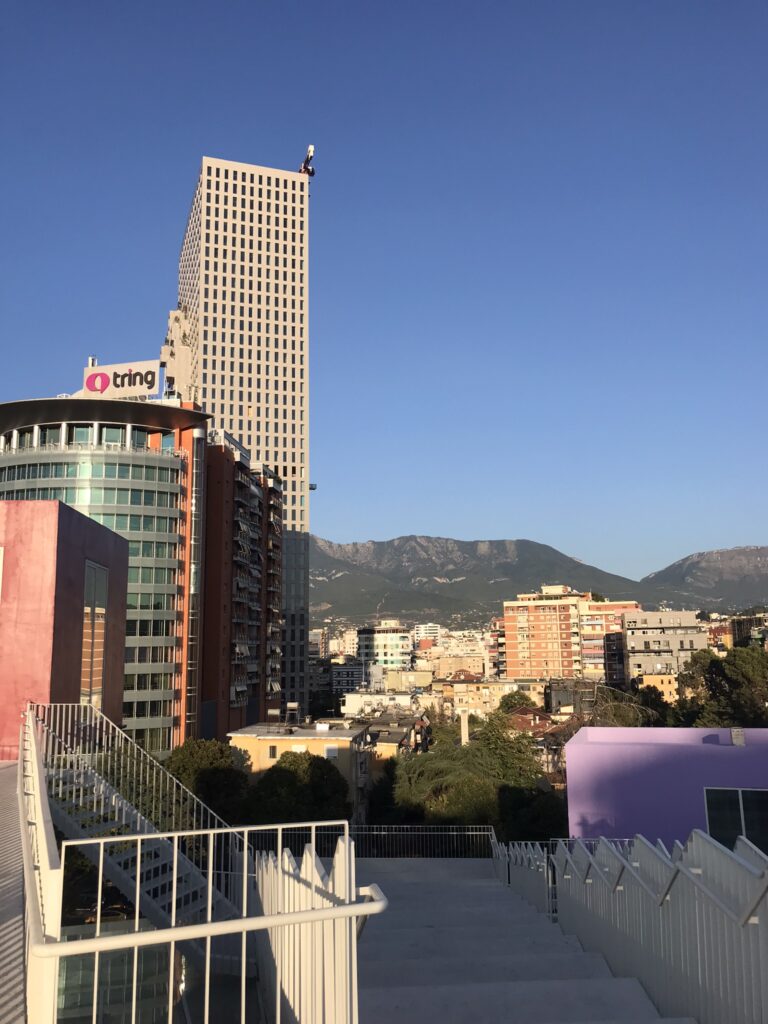
Atop of the Pyramid of Tirana
Tirana is a sprawling metropolis, one of the biggest cities in the Balkans, and is a symbol of modernity in a country still struggling to catch up with the rest of the region. Many aspects of Tirana hark back to the country’s communist past, from the ominous Pyramid and House of Leaves to the huge, open Skanderbeg square and the city’s many bunkers. In an effort to stimulate the economy, the government of Albania has embarked on an ambitious building project; many unique high-rise buildings and tower blocks are under construction in Tirana, which are intended to be emblematic of the city once they are completed.
Accommodation
An Airbnb close to Skanderbeg Square.
Foodie Places
Restorant Tymi – I loved the quirky décor of this place from silly pictures of Mona Lisa with a beer moustache to a disco ball hanging from the ceiling and pink, glowing electric guitars draped across the wall. The toilets were seriously cool too! The food was tasty and the prices were reasonable too.
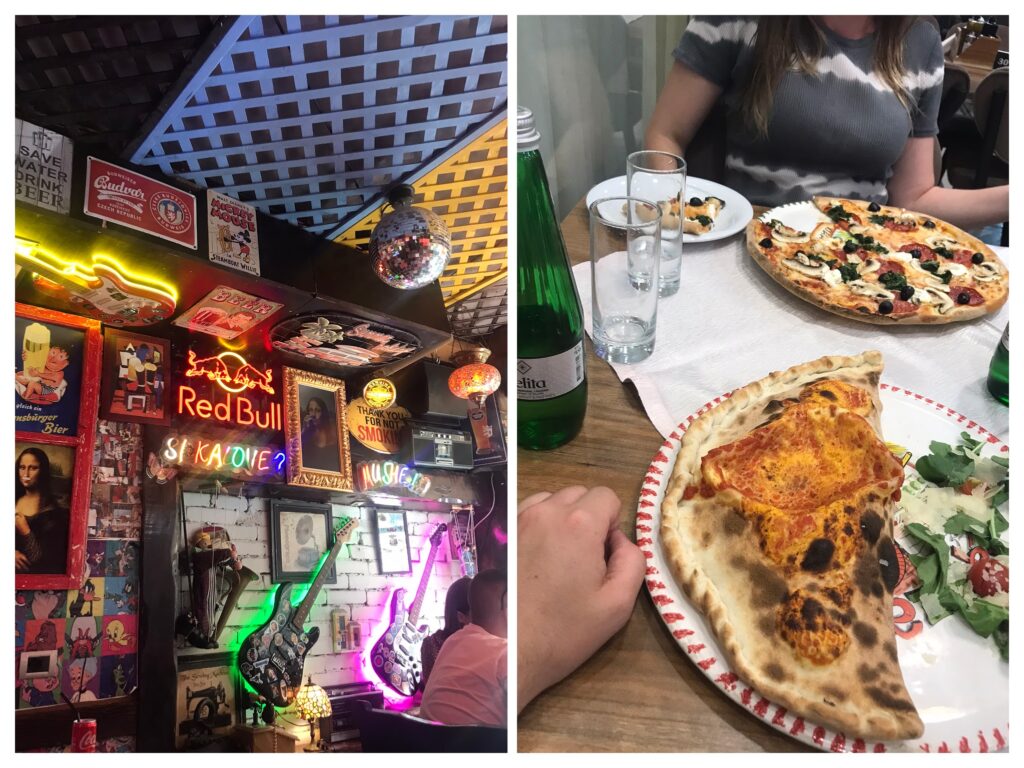
Restaurant Tymi is decorated like a budget version Las Vegas while Golosa is a more traditional Italian joint.
Golosa Pizzeria Ristorante – an unexpected find in a nondescript shopping mall, you’ll find great authentic Italian pizza served here. We spotted some Italian patrons here so the food must be good!
Activities
Free walking tour with Guruwalk, stops included Skanderbeg Square, Et’hem Bej Mosque, The Clock Tower of Tirana, Orthodox Cathedral, Albanian Parliament, Catholic Cathedral, Namazgah Mosque.
Tirana Castle – not really a castle but instead a collection of upmarket restaurants with high prices.
Pyramid of Tirana – this bizarre landmark was built during the final years of the communist dictatorship and stood awkwardly unused for many years afterwards as an ominous reminder of the country’s strange and dark past. The pyramid was recently repurposed, given a vibrant paint job and stairs were installed allowing people to climb to the top and cast an eye over the skyline of Tirana. The inside of the pyramid seemed to be being set up as some sort of conference or exhibition space, but we didn’t go inside. There’s no entrance fee to climb the outside of the pyramid.
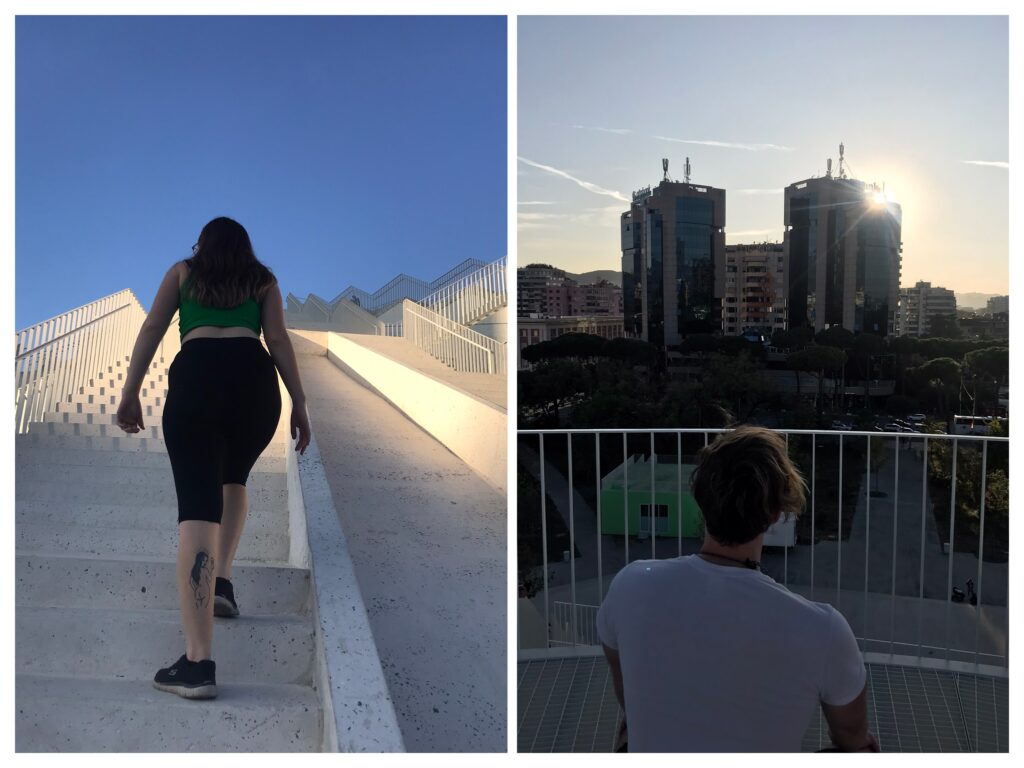
The Pyramid of Tirana is a lively place with plenty of local youngsters and couples around during sunset.
Underground Bunker – location: 41.321046, 19.820188, one of the 750,000 bunkers constructed during Hoxha’s rule, bunkers ranged in size from 1 or 2 person pillboxes which were designed to be used as defensive posts in case of incursion by hostile forces and larger, complex underground nuclear bunkers designed to shelter and accommodation Hoxha’s government so that it could still function even during a nuclear conflict, Bunk’Art 1 & 2 are examples of these nuclear bunkers.
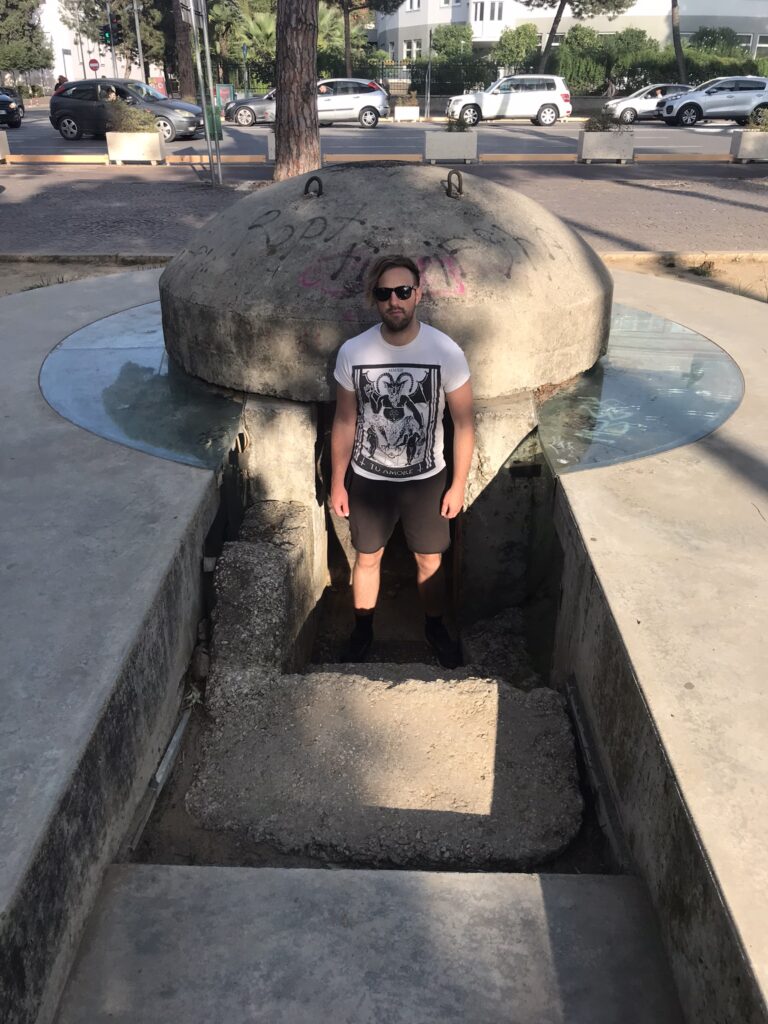
Watch out for human faeces in the bunkers – we found a delightful treat inside one!
Enver Hoxha’s Former Residence – apparently no one knew what to do with the former leader’s home so it’s been kept exactly the same as when he died, all the original furniture is still in situ, according to our walking tour guide no one is allowed to enter except the cleaner. You can view from the outside through the gate and it has become a minor tourist attraction, although it is really just a normal-looking mansion house. It’s interesting that this place wasn’t destroyed or ransacked by the people as is common with most symbols of repressive communist regimes.
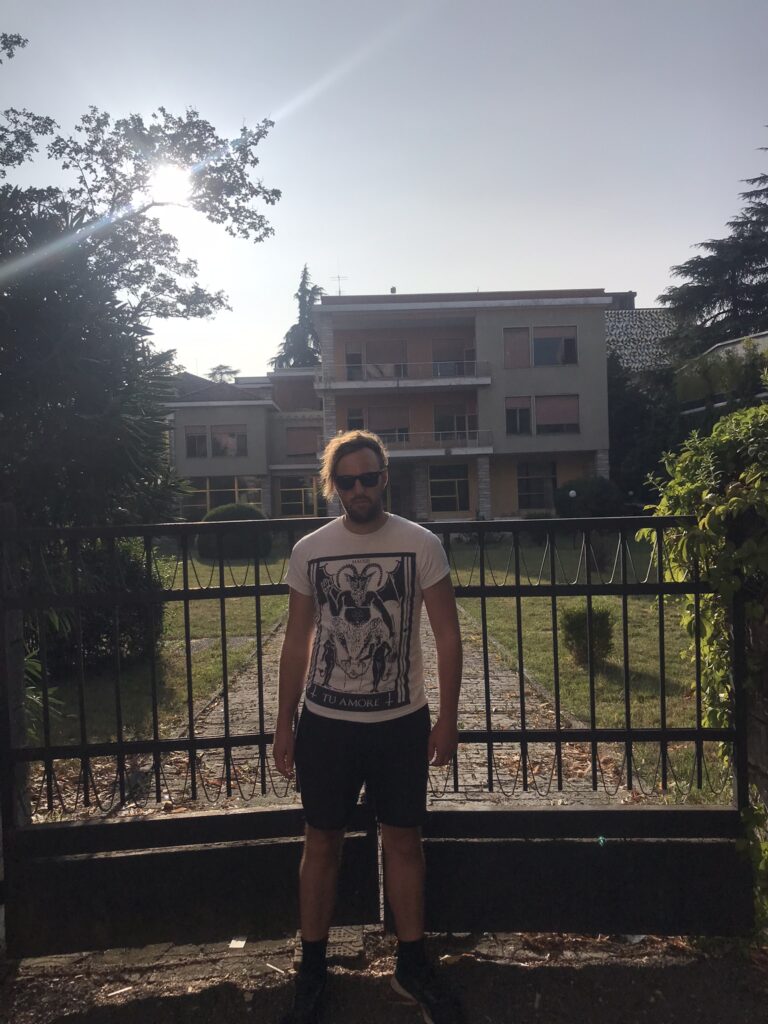
Rubber-necking at Enver Hoxha’s residence in Tirana
Bunk’Art 1 & 2 – not the best place to visit if you’re claustrophobic. Bunk’Art 2 is the slightly smaller of the two, it’s much easier to reach from central Tirana as it’s close to Skanderbeg Square but this also means it’s more popular amongst tourists. We found Bunk’Art 2 to be much busier, which made trying to read the info boards quite challenging in the narrow passageways and compact rooms. Both underground concrete bunkers are dark and dingy but filled with interesting displays and information about Albania’s modern history.
Bunk’Art 1 – To get to Bunk’Art 1, head to Skanderbeg Square and wait at this bus stop behind the Palace of Culture for the number 11 bus. We got off one stop too early and had to walk through a residential estate but we managed to catch the bus back from a bus stop close to the entrance to Bunk’Art 1 (41.349557, 19.859857). Bunk’Art 1 contains a ton of information about the history of Albania including its invasion in World War 2, (sour) international relations with Yugolsavia, Russia and China, how the communist regime came to power and Enver Hoxha himself. As part of the exhibition, you can visit the private quarters of Enver Hoxha and his staff. His rooms still contain his personal desk, phone, bed and even a radiator. It’s a great visual aid and reminder that these bunkers were designed to be lived in by Hoxha and his staff during a nuclear war and function as the seat of government. There’s even an underground theater which would’ve had the dual function of being the parliament and an entertainment hall.
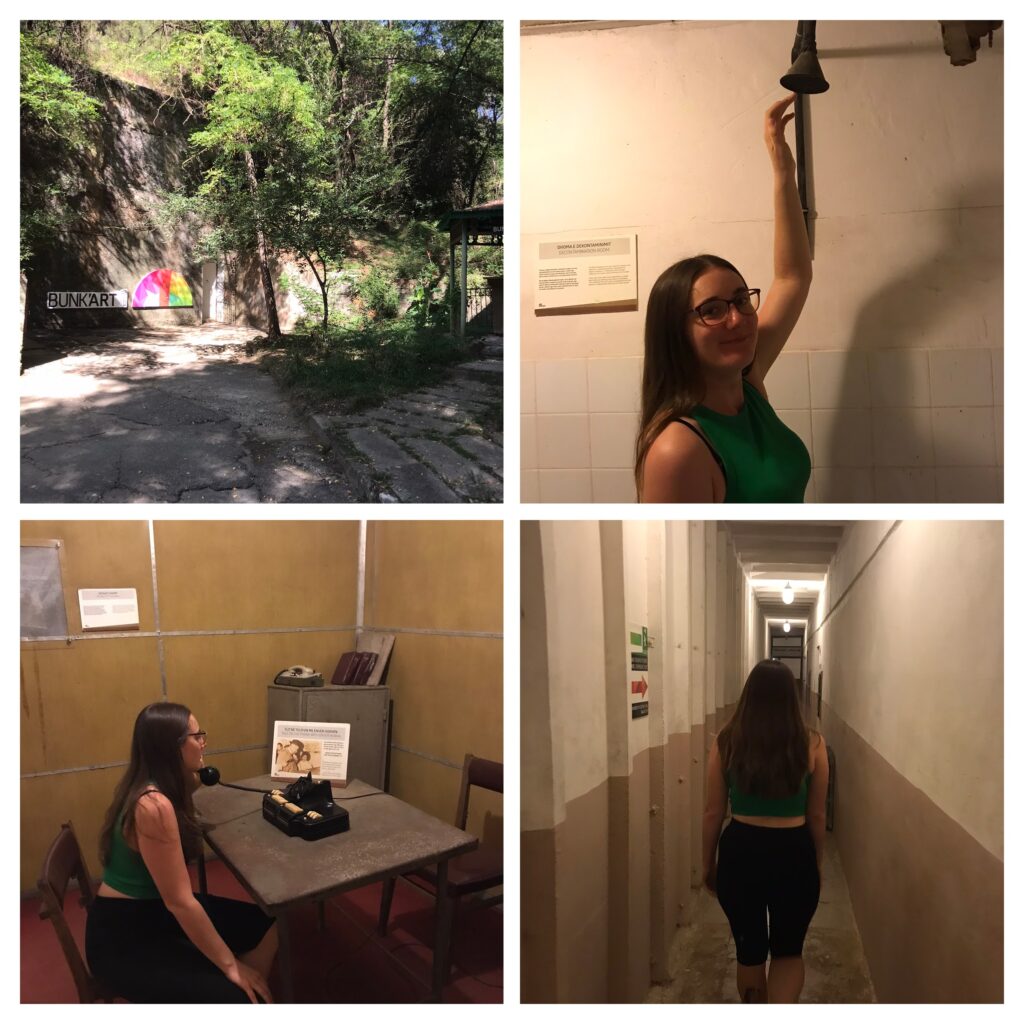
Exploring the underground network of tunnels at Bunk’Art 1
Bunk’Art 2 focuses on the role of the Sigurimi and includes personal testimonies of those who endured torture, imprisonment and internment in forced labour camps. I was surprised to learn that it wasn’t just those accused of subversion but also their families that were forced into internment camps alongside them. It wasn’t just the individual that would suffer but their whole family including children who experienced the harsh conditions of the camps. It’s hard to watch the video testimonies of survivors of these camps. In the final rooms, there are details pertaining to the torture methods used by the Sigurimi. Overall a very harrowing exhibition.
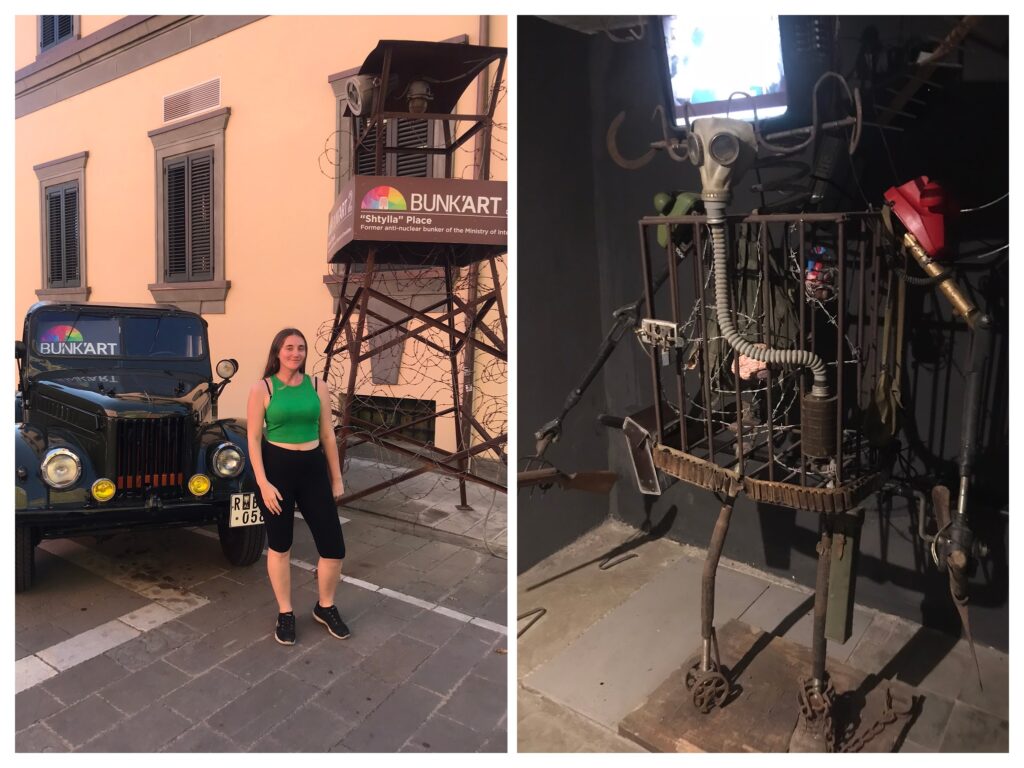
In Bunk’Art 2 there are some modern art exhibits, as well as info boards and displays, I was particularly interested in one display featuring a robot-like creature which symbolises aspects of communist regime in Albania
House of Leaves – a very informative exhibition located inside the former Sigurimi building used by Hoxha’s regime to conduct state surveillance in Tirana. Inside the museum you can find displays with covert filming and listening devices, you can see objects that had cameras hidden in them including clocks and canes. It’s even possible to watch original footage filmed by Sigurimi. One of the rooms was bugged with listening devices and it was creepy to experience the feeling of being watched/listened to. There’s also information about mail checking practices as well as visual testimonies to interrogations and imprisonment during the regime. It’s a real eye-opener to read about the extent of state intervention and control over people’s lives.
Durrës
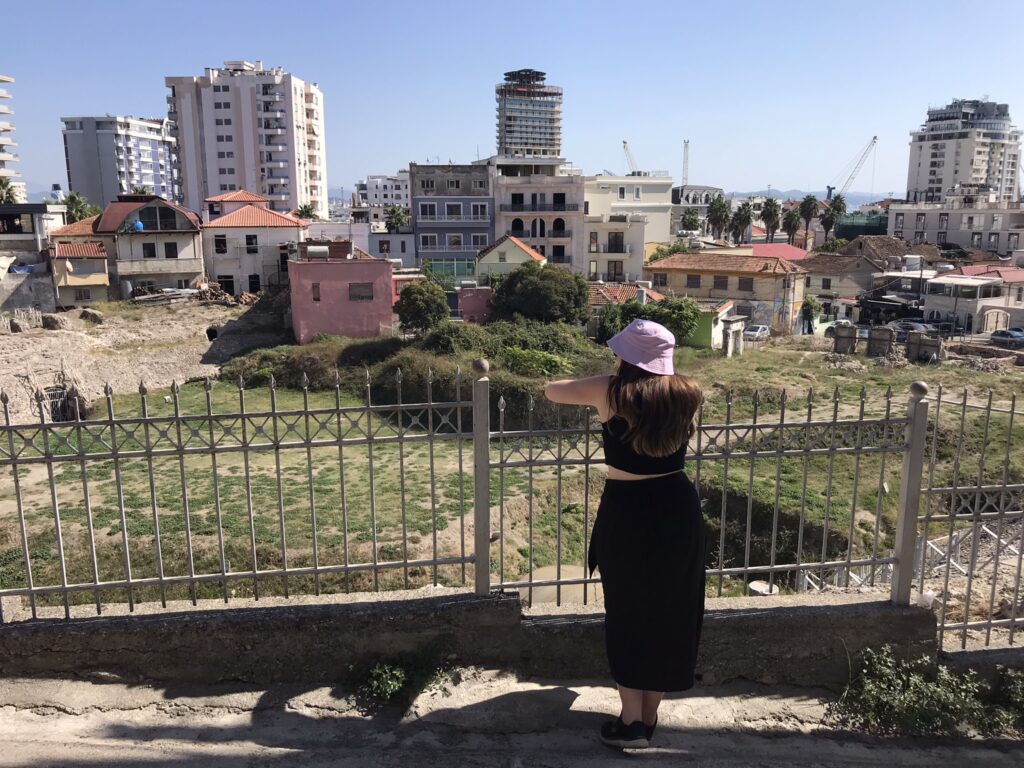
Durrës is a burgeoning popular destination for European holiday-makers looking for sun, sand and most importantly cheap prices. The Port of Durrës is one of the largest ports on the Adriatic sea with frequent ships crossing from Italy. Durrës also has an interesting past, facing invasion by Italy’s navy during World War 1. It’s possible to visit Durres on a day trip like we did as it’s quite close to Tirana, it’s only about an hour away by bus.
How to get there
From the city center in Tirana, you need to get to the South and North Albania Bus Terminal (Bus Station) to catch the bus to Durrës. It’s possible to catch the Instituti Bujqesor bus to the bus terminal from this bus stop.
Activities
We opted to use GPSmycity for a self-guided walking tour with stops including the Venetian tower (it’s possible to go inside and up the stairs to the lookout for free), Amphitheatre, Town Hall, Town Square, the Great Mosque, Byzantine Forum, Southern Gate of the Castle, Promenade and Pista e Re Bridge. It’s possible to hike up to the former summer house of King Zog of Albania called Vila e Ahmet Zogut however we didn’t do this as we couldn’t face the uphill walk! Within walking distance, past the commercial port area, is the Beach of Durrës, it’s a nice place to relax after the self-guided walking tour with many restaurants and bars lining the beachfront.
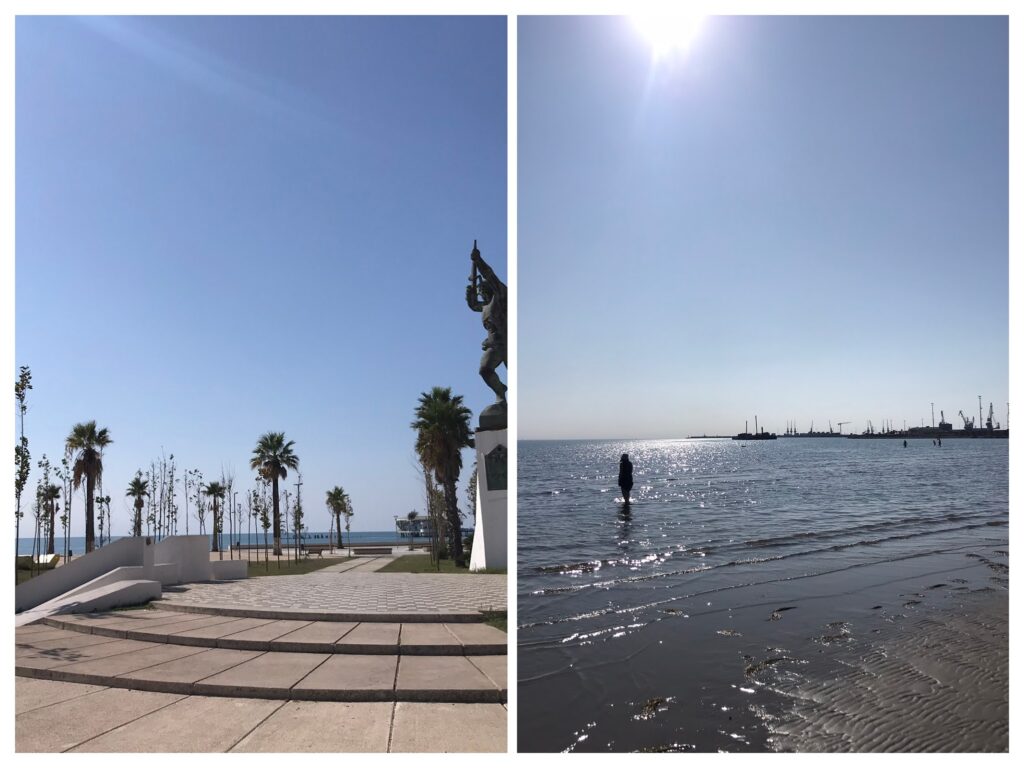
Foodie Places
Sema – located directly facing Town Square; it’s a great place to sit, nibble on a sandwich and people watch.
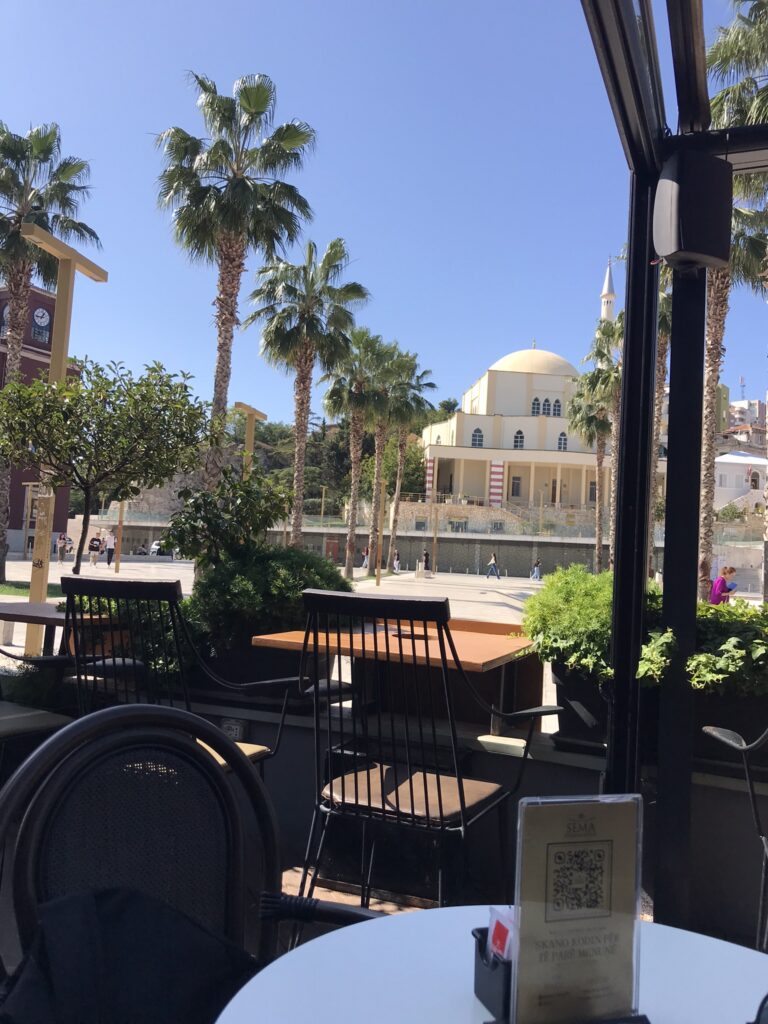
For the best views of Town Square, enjoy a sandwich and cold coke at Sema
Berat
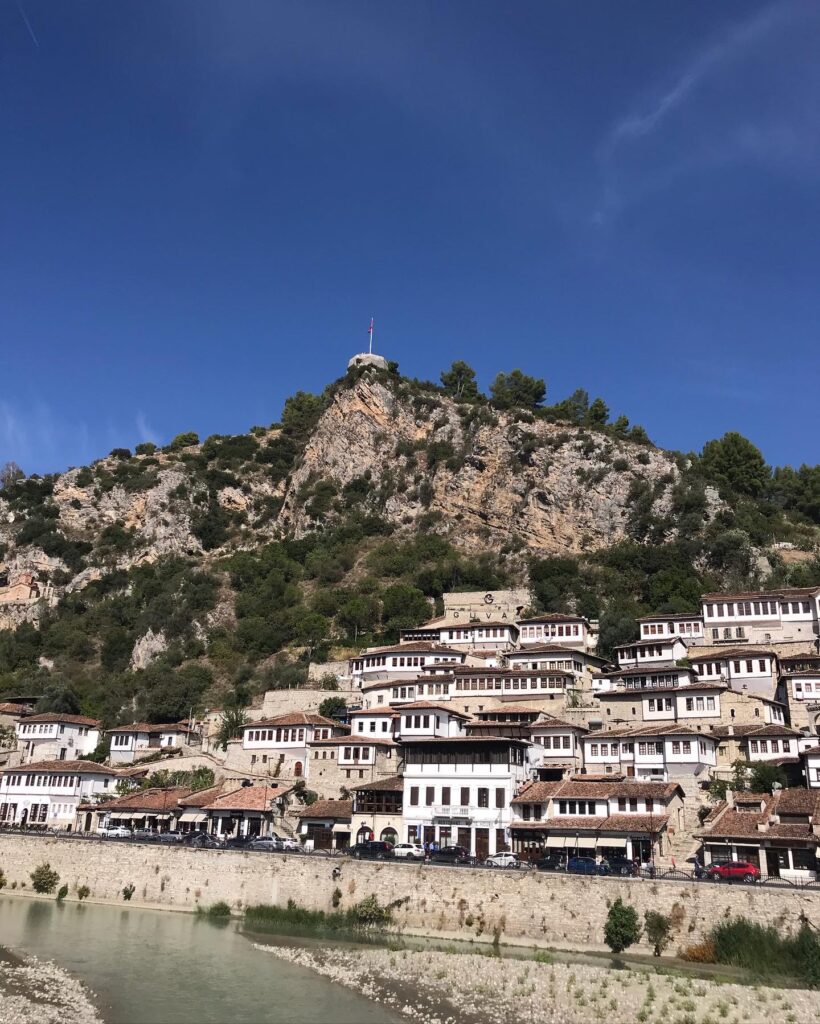
Officially named a UNESCO World Heritage Site in 2008, Berat boasts a mixture of architectural styles absorbed from different civilisations. From the Ottoman influence visible in the Mangalem district and mosques dotted around the Old Town to the more traditional Balkan architecture of the Gorica district. Berat is widely famed as the ‘City of a Thousand Windows’. It’s a joke amongst locals when foreigners come to visit and ask about the thousand windows thing, there aren’t actually a thousand windows; it’s commonly thought to be a mistranslation of an Albanian word for ‘thousand’, which should actually be translated as ‘one over another’ due to the city’s architecture built into the side of the hill.
Mount Tomorr sits facing the city of Berat, its slopes are a pilgrimage site for Christians and Islamic Sufis alike. Albanians widely consider it to be a holy mountain. According to Albanian legend, Tomorr was originally a giant, who fought with another giant (mountain) called Shpirag over a young lady. They killed each other and the girl drowned in her tears, which then became the Osum river. This river flows through Berat separating the Gorica district from the Mangalem district. It’s possible to book day trips to Tomorr and the surrounding area.
Accommodation
Guva Mangalem (reported as temporarily closed on google) – situated in the Mangalem district, this traditional Ottoman house now serves as a bed and breakfast and restaurant. We had a pleasant stay and the hostess was very friendly and accommodating. There are great views over the Osum river and Gorica neighbourhood from the terrace.
Foodie Places
Te Zalua – situated at the top of Castle Hill close to the Viewing Platform, this café is an ideal place for lunch or a refreshing drink after the sweaty walk up the hill.
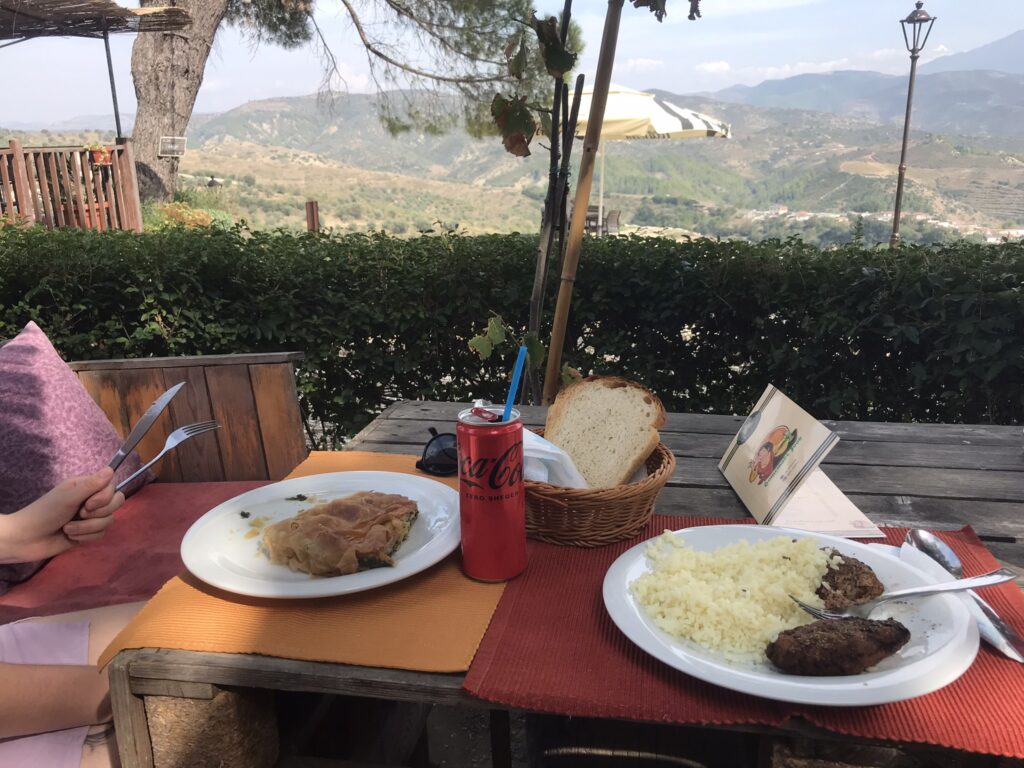
Te Zalua is the perfect vantage point for stunning views over the city of Berat and surrounding area
Friendly House – We loved the moussaka and fërgesë (considered one of Albania’s national dishes, fërgesë is a traditional Albanian cuisine that features roasted red peppers, tomatoes, and cottage cheese). It was nice to sit out on the terrace and enjoy the view over the Osum river with the twinkling city lights in the distance.
Activities
Free walking tour with Guruwalk with stops including Gorica Bridge, Gorica neighborhood, Church of St. Spiridon, Mangalem district, Halveti Tekke and Xhamia Mbret, Republic Boulevard (main pedestrian street with restaurants and cafes).
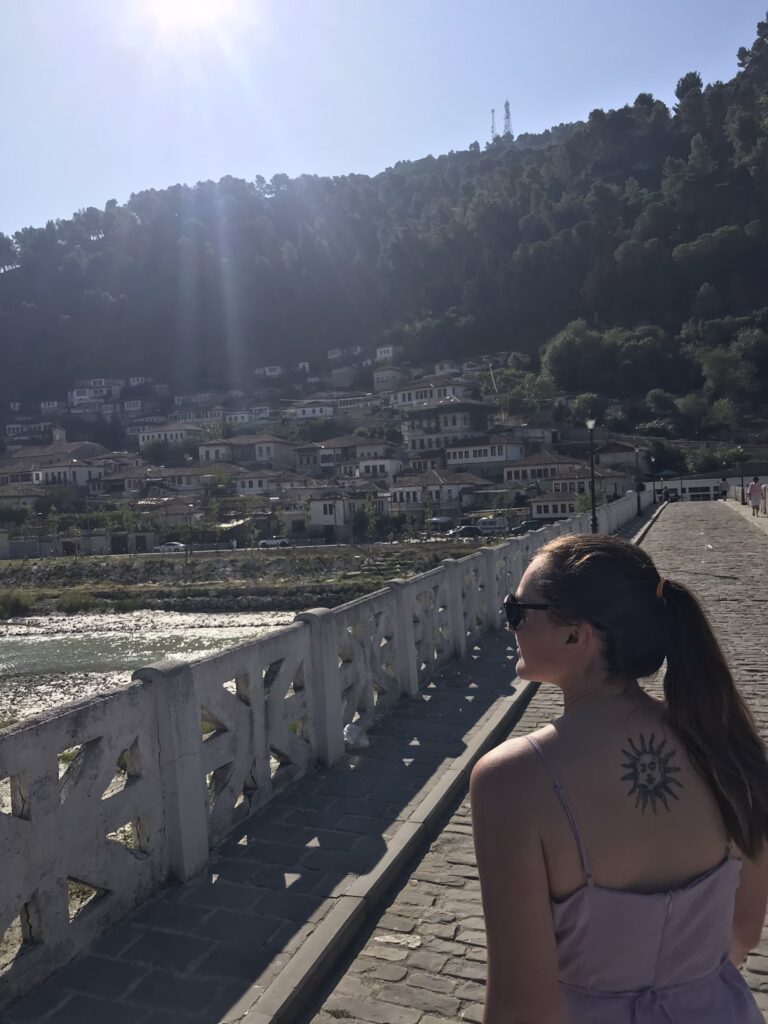
Gorica neighbourhood is just over the bridge from Mangalem district
Berat Castle – This Byzantine walled citadel, inaccurately described as a castle, is unlike many other walled citadels in that it has both the ruins of mosques and Orthodox churches that are still in use to this day. Local residents still live here amid the growing number of guesthouses and restaurants popping up to cater to the influx of tourists. I recommend wearing trainers and preparing yourself for a steep ascent to the top. Make sure you use the ‘shortcut to Berat Castle’ walking trail to reach the top of the hill, it is quite a climb! Some of the best sites to check out are: the Viewing Platform (unbeatable panoramic views of the Old Town, Gorica neighbourhood and newer residential districts), Kisha e Shën Gjergjit (an Orthodox church now derelict and crumbling away), Ruins of the Red Mosque, Ruins of the White Mosque, Holy Trinity Church (cute little Orthodox church tucked into the hill-side).
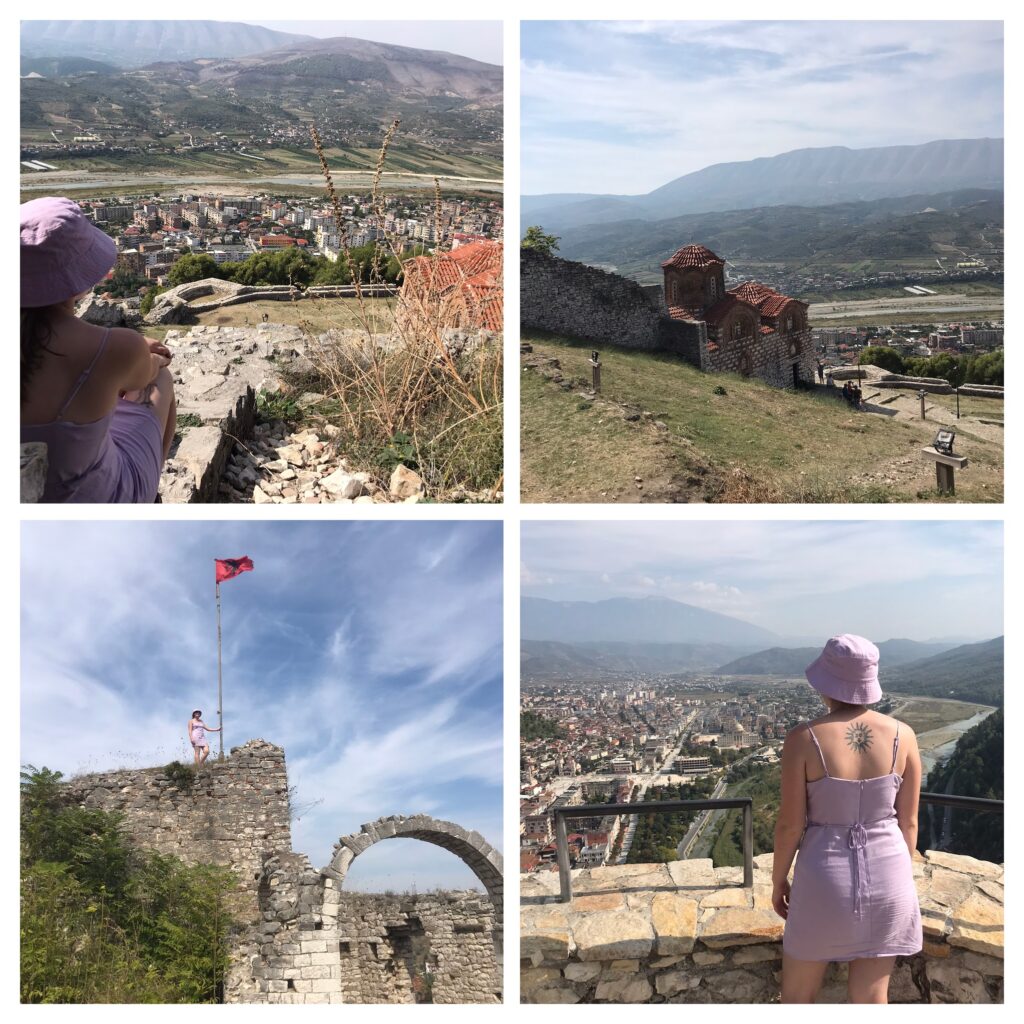
The trek up to Berat Castle is worth it, I promise!
Shkodër
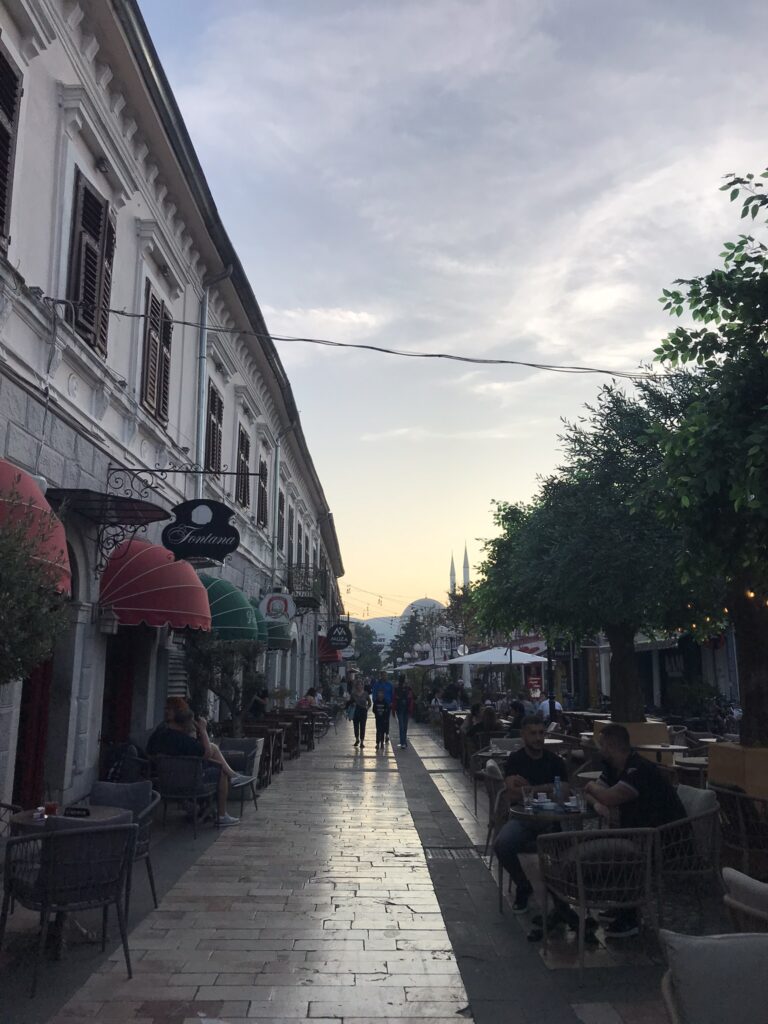
Rruga Kolë Idromeno at sunset
Shkodër is a city in northern Albania close to Lake Shkoder and the border with Montenegro. The city has an interesting history, it was fought over for many years by various states and factions, eventually settling as part of Albania rather than Montenegro. Shkodër is known as a city of bikes, bicycles are everywhere here. The city centre of Shkodër is quite cosmopolitan although the outskirts seemed much less developed. During the short walk to Rozafa Castle the surroundings quickly went from high–end fashion boutiques to kids running around with no shoes on and toothless old men drinking together in dilapidated porches. Dan spent most of the first evening in Shkodër curled up in bed with a nasty bout of food poisoning from Tirana.
Accommodation
Shkodra 27 Center House reserved with Booking.com – great value for money, it turned out to be a whole house rather than just an apartment which was fantastic. The kitchen was fully equipped with everything we needed to cook (even though we didn’t!) and the owner was particularly friendly. He was an Albanian guy who’d lived in London for 20 years. It was so strange to hear a London accent in the middle of Albania. When he first started talking to us, I was very confused!
Foodie Places
Fish Art – don’t order a non-fish dish like me, this restaurant serves fresh fish and seafood. They even have a fishmongers counter where you can choose which fish you want to have. I don’t know what I was thinking, ordering pasta with a tomato sauce. A temporary lapse in sanity perhaps! Dan’s seafood pasta was dreamy, it even had crab in it!
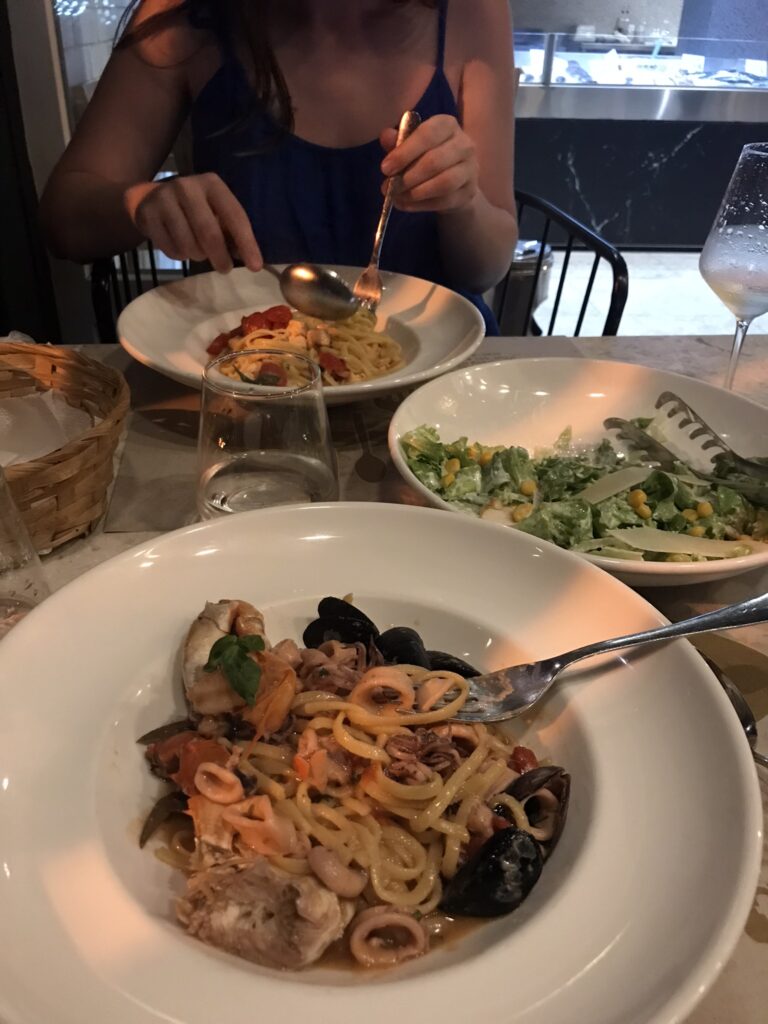
Swanky food at Fish Art
Il Mulino Shkoder – tasty pizza and just across the road from where we were staying. This was ideal when Dan was laid up in bed with food poisoning.
Activities
Free walking tour with Guruwalk including stops at Xhamia e Parrucës, Town Hall, The Memorial of Democracy Heroes, History Museum, Market and Rruga Kolë Idromeno (the main pedestrian street in Shkodër, filled with nice restaurants and cafes, it becomes a hive of activity during the weekends and evenings as locals sit outside and enjoy a cocktail or two.)
Rruga G’juhadol is the perfect setting for an evening stroll, this area is in the process of gentrifying so pretty little restaurants sit alongside abandoned buildings. It’s the best place to grab a glass of wine and while away the evening with good company. The buildings on the street are very picturesque especially around sunset with delicate hues of pink and yellow.
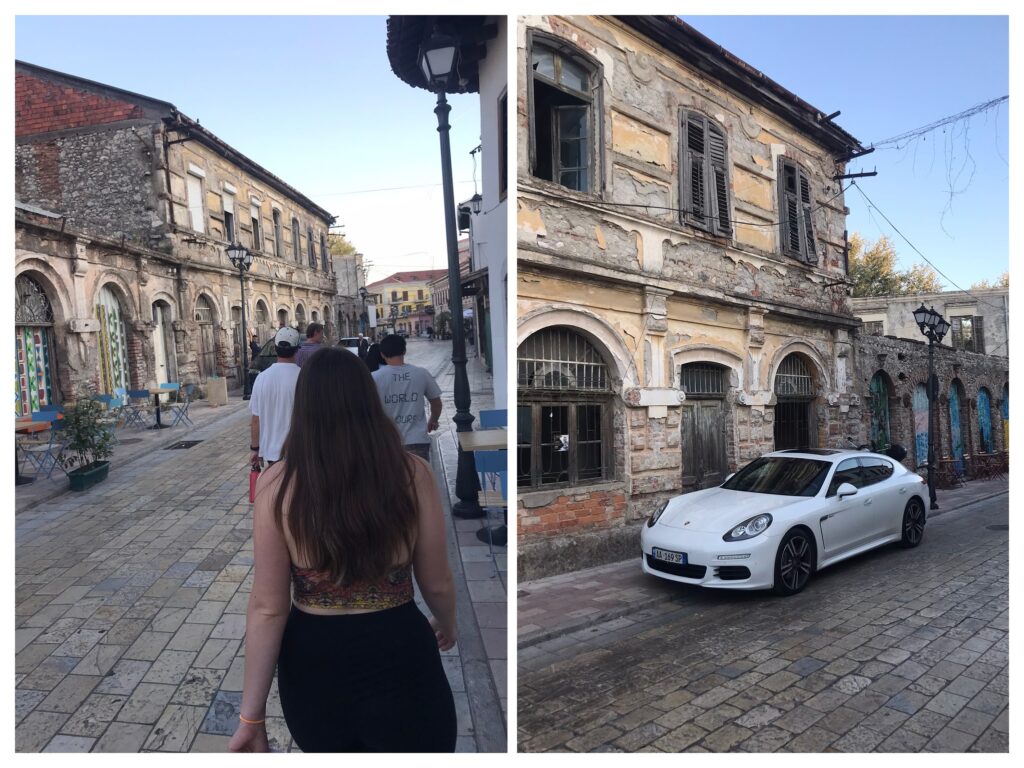
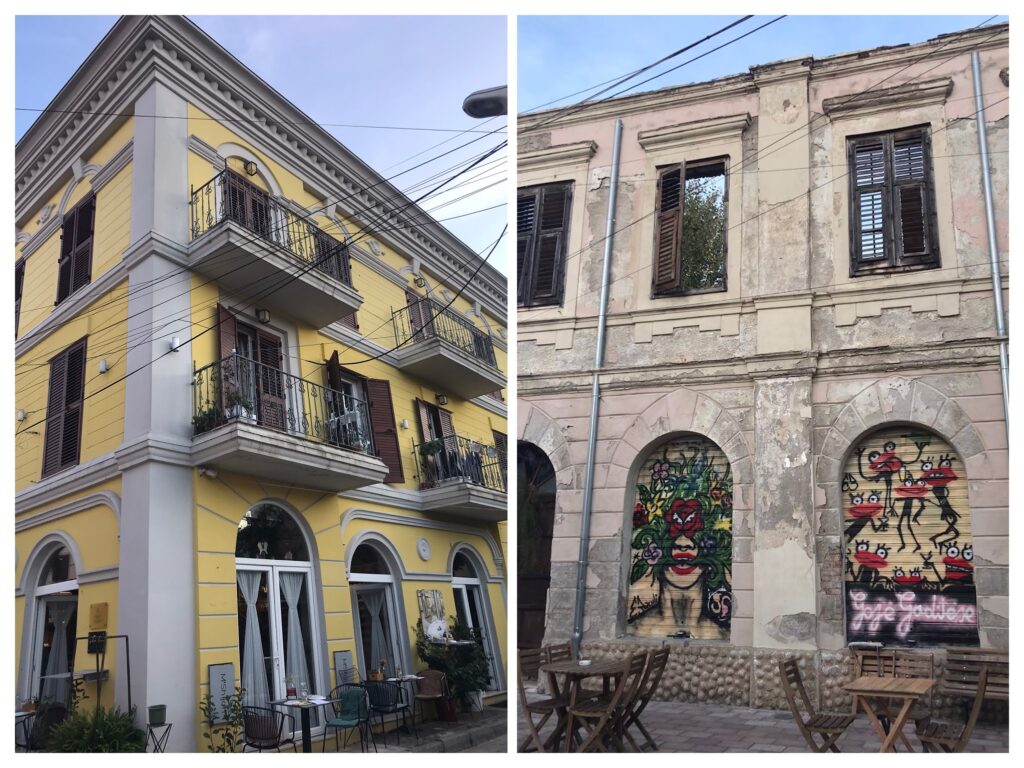
Rozafa Castle – it’s possible to walk to the castle from the city center, we did. Climbing the cobble-stone path to the top reveals fantastic views over the lush green countryside surrounding Shkoder, the aqualine Buna river merging into Shkoder Lake and the impressive city of Shkodër nestled in the valley. We thoroughly enjoyed meandering around the castle ruins and admiring the great panoramic views.
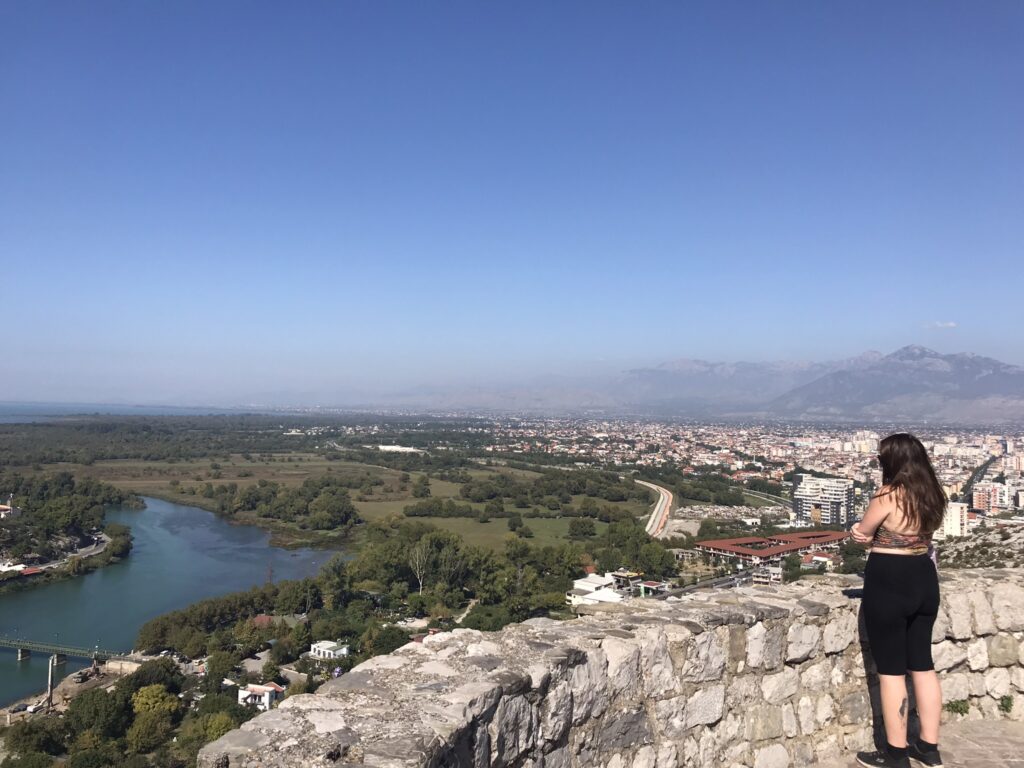
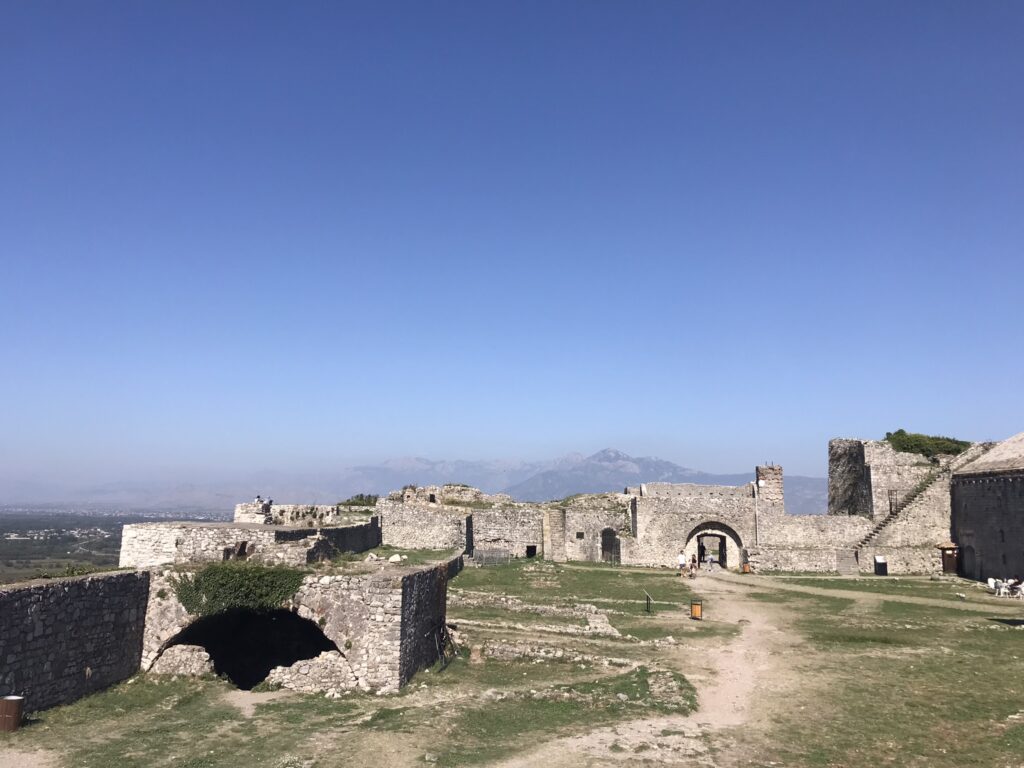
Rozafa Castle, the view from inside and outside
We got the bus to Podgorica in Montenegro from Shkodër, this departed from the side of the main road Rruga Teuta in the centre of Shkodër (marked ‘bus station’ on google maps but there is no physical station, the buses just pull up at the side of the road. Location is at 42.06770169784331, 19.512914686662548). Be aware as there are many guys around here looking to scam tourists, offering expensive taxi ride across the border or trying to usher you into less reputable buses. We waited for the specific bus that we had planned to get, with a schedule and price which was listed online on GetByBus. It was a little awkward as we didn’t buy a ticket online, we gave some cash to the driver when he arrived and he seemed happy enough but I’m pretty sure there is a good chance he just pocketed the money. He was cheerful and jolly when we got to Podgorica, but I would probably recommend buying a ticket in advance in case you have a driver who is not so nice.
